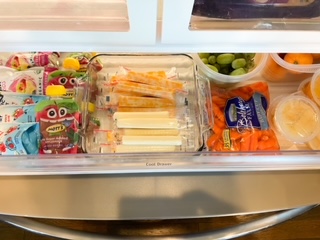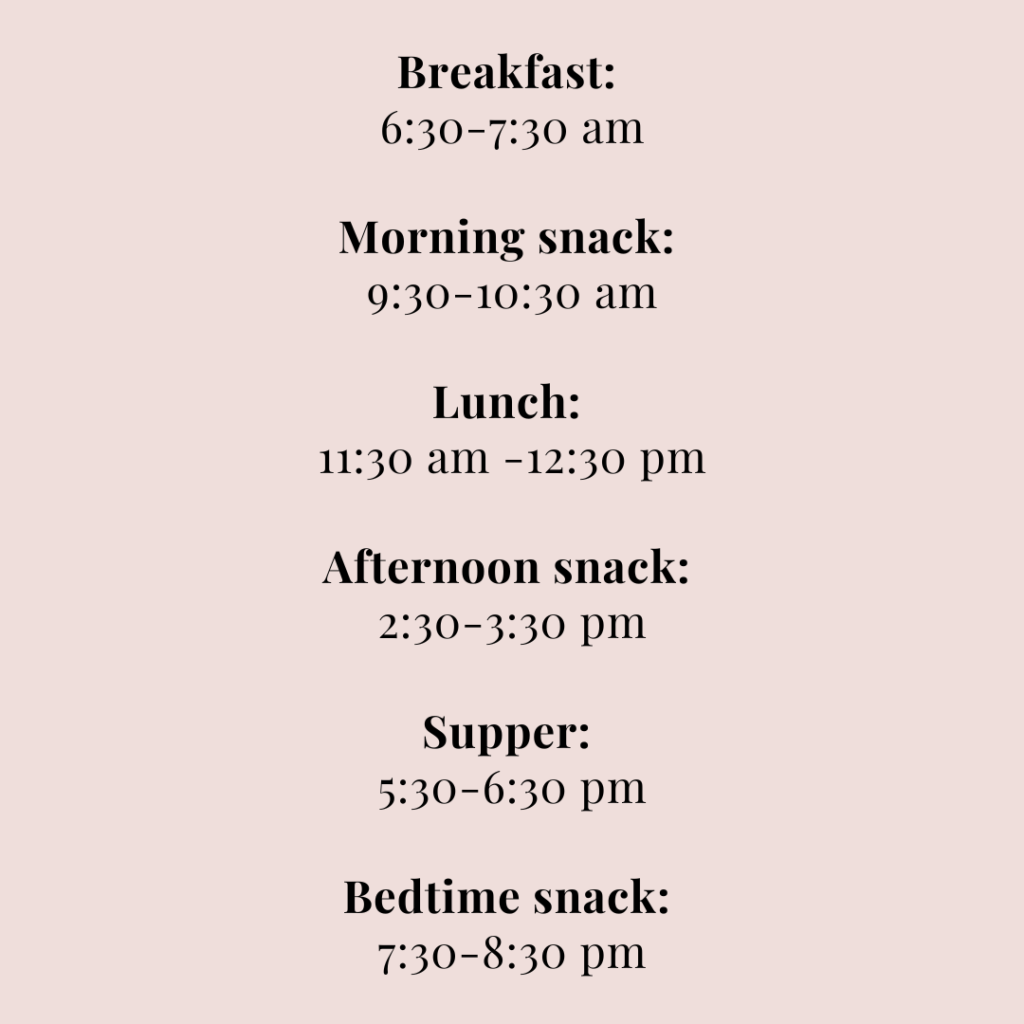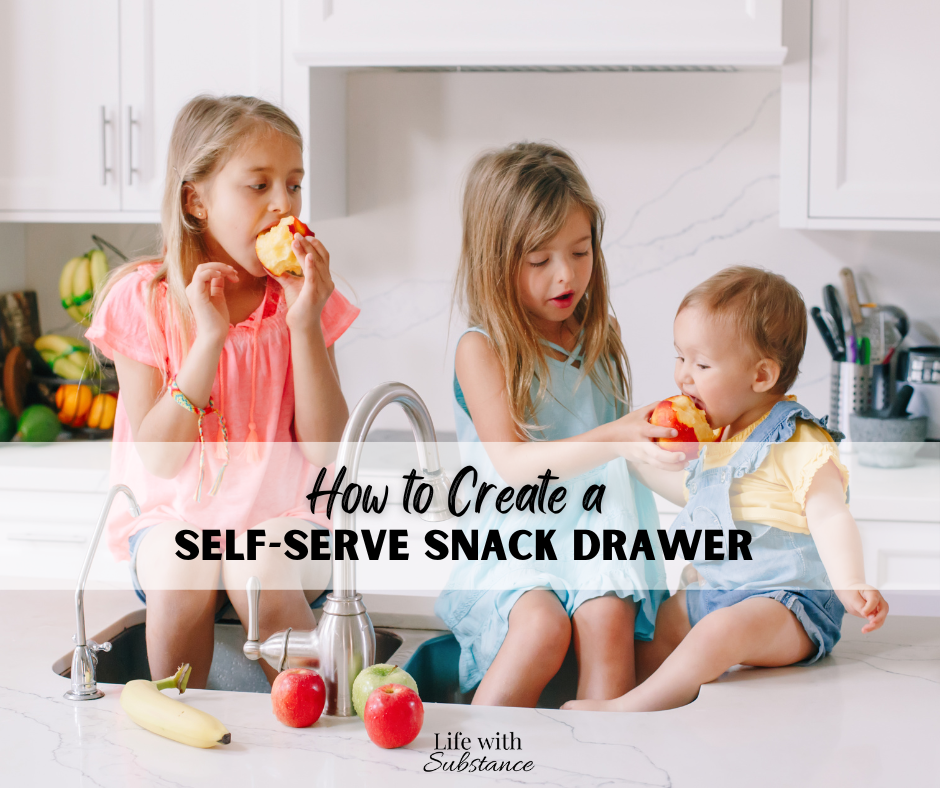This post may contain affiliate links. If you shop from one of our links, we may earn a commission.
“MOOOOMMM! I’m still hungry! Can I have a snack?” You cringe as you hear the words you knew were coming. You had just dumped their barely touched lunch in the garbage not 30 seconds ago. The same lunch you had put a little extra effort into trying to add some variety into their diet. They were not impressed, and you feel defeated. Lunch was a battle and you don’t have the fortitude to plan a snack after you just finished cleaning up lunch. Luckily, you don’t have to when you have the self-serve snack drawer for kids.
When my oldest was 2 years old she started to have more of an opinion on when she wanted a snack. She frequently entered the kitchen pantry and pulled food off the shelves to find what she wanted. I quickly realized I needed to establish healthy boundaries around managing snacks in our home. At this time I decided to create a snack drawer for kids. We have been using this system for the past 6 years, and I honestly wouldn’t do it any other way.
It has helped me keep my sanity by preventing my kids from constantly asking for snacks and wanting to know what they can and can’t eat, while also allowing them ownership over their snack choices. Over the years our snack drawer for kids has evolved as my kids go through different preferences, feeding stages, and how we utilize it. Let’s talk about how you can also recreate this self-serve healthy snack drawer for kids in your own home.
Benefits of a Self-Serve Snack Drawer for Kids
– Independence with snack choices as they get older
– Sets healthy boundaries around snacking
– Easy way for babysitters to know what options are available for the kids
– Helps kids to take ownership of their own snacks
Creating a Kid-Friendly Snack Drawer
The first thing to decide is where you would like to keep the snacks. It has always worked well for our family to have a designated drawer in the kitchen cabinets that my kids can go to for snacks. But don’t feel like you have to clear out a space in your kitchen if that doesn’t work well for your situation. It can be as simple as grabbing a cardboard box or a container to keep your snacks in. I found some clear containers at Aldi’s to help create snack sections for various options and to better help organize the space. You could also use wire baskets, plastic containers, or shoeboxes to separate snacks if you wish. The goal is not to do a pantry makeover or create a Pinterest-ready space for your kids, but rather a holding space for their snacks.
I also highly recommend designating a space in your refrigerator for snacks. It can be clearing out a drawer in the fridge if that’s an option. If not, feel free to grab a small box, clear bin, or Tupperware container for storing snacks. I’ll explain more about the reason for a snack space in the refrigerator in a little bit. Once you have determined where and how you want to keep your snacks you can now decide what snacks to provide.
Stocking the Self-Serve Snack Drawer for Kids
I typically restock our snack drawer in the cabinets and the fridge once a week. If I notice the items are getting pretty low toward the end of the week I will add a few more options in there to get the kids through the week, but generally, once a week is sufficient for our family with 3 little ones. If you have a larger family and older kids that need more food to sustain them, you may find you need a larger snack space or will need to restock halfway through the week. Let’s talk about what to include in your snack drawer areas.

Three Components for Well-Balanced Snacks
Has your kid ever left the table, only to come back a half hour later stating they’re still hungry? It may be because they didn’t include these three components to help sustain them: protein, fat, and fiber. These three nutrients are a great way to curb your child’s appetite between meals and prevent the need for grazing. Below are some examples of snacks that meet these three components. Keep in mind that some foods can meet multiple nutrients. For example, whole-fat Greek yogurt provides a great source of protein and fat. Mix in some fruit for fiber and you have a well-balanced healthy choice.
My kids are 8, 6, and 3 years old so I still provide a fair amount of education about creating a balanced snack. When your kids are younger you can lay the groundwork for what foods provide protein, fat, and fiber. For little ones, they will require your assistance with putting together their snack. I typically ask my little one what she wants for a snack and then balance it with any remaining nutrients she didn’t get. There are times when she won’t eat the additional items I provided, which is totally fine. The Division of Responsibility simply states that parents can choose what the family will eat, when, and where. The kids can determine whether and how much they want to eat.
Now keep in mind, not every snack will be perfect. Perfection is not the goal. Rather we are trying to encourage our kids to think about how to create a balance of nutrients so that it becomes second nature when they are older. But there are definitely going to be snacks where all your kid wants is Goldfish, and that’s okay. For my kids with a sweet tooth, I will occasionally offer items such as fruit snacks. Allowing a sweet snack option still lets my kids know that we do not have “forbidden” or “bad” foods. All foods can be enjoyed in moderation.
Placing foods on a pedestal or creating restrictions will make your child seek them all the more, and will likely overeat them when given the option. You can read more about allowing sweets here. There are days as adults when we just crave certain foods and lack variety. That doesn’t make us unhealthy because we know we will get variety again at other meals and snacks.
Refrigerator Snacks
Kids naturally tend to migrate toward the pantry or snack drawer space for more of the non-perishable options that tend to be more carb-heavy. Creating a space in the fridge can help them choose a larger variety of items and some that may be more nutritious such as fruits and vegetables. Fruits and vegetables wouldn’t typically be my kids’ first choice of snack items. As a way to help encourage them to check the fridge more, I will often put items in there that wouldn’t necessarily need to be refrigerated. For example, I will occasionally refrigerate Lara bars or other granola bars in hopes that they will notice other items in the fridge to balance out their snack. You could also encourage your kids at snack time to choose 1 item from the pantry and 1 item from the fridge.
I typically go grocery shopping on Sundays, so this is generally when I will restock the snack spaces. During this time I will prep fruits and vegetables for easy access. Placing individual portions in a Ziploc bag is handy when your kid needs a snack bag on the way out the door. Fruit will stay fresh in glass jars with a lid throughout the week if you’re worried about any of it going bad before the week is up. If the kids aren’t consuming the produce quickly enough before it goes bad I will serve it with meals to prevent any of it from expiring.

Refrigerator Snack Ideas
Guacamole cups
Cheese sticks
Yogurt tubes
Squeeze fruit pouches
Hummus cups
Chopped and prepped fresh fruits and vegetables
Hard-boiled eggs
Ranch dip cups for veggies
Almond butter, peanut butter, or other nut butter of choice in a single serving size to grab for dips
Cheese slices for crackers
Healthy Snack Ideas with Protein, Fat, and Fiber
Apple with peanut butter
Whole-fat Greek yogurt with fruit
Trail mix with dried fruit
Carrots with ranch and string cheese
Veggies with hummus
Guacamole with pita chips and veggies
Dry cereal with fruit (find out how to pick out a healthy cereal for kids here)
Freeze-dried fruit with goldfish crackers
Whole grain crackers with cheese slices
Mini That’s It bars with Beef Jerky
Pretzels with mini Lara bars
Purchasing in Bulk
Purchasing snacks in bulk can be a more cost-effective way to purchase food. I personally like to purchase our snacks in bulk, however, I do have to be cautious that my kids don’t become dependent on these snack foods. If you notice your child reaching into the snack drawer for the 30th time for their favorite granola bar only to discover they are all gone, your child may be dependent on this item. When purchasing in bulk, our kids may also become limited in their food choices because they know they have a large stash of their favorite items.
To prevent kids from becoming dependent on the same snack foods, try switching them out each week. Even though you have a large box of this particular snack food, take turns alternating it with other options. This allows your child to include more variety within their diet while preventing dependency on that snack food.
How to Set Boundaries Around Access to the Snack Drawer
A main concern for many parents with the self-serve snack drawer for kids is that their children will constantly be in the snack drawer and binge on the entire bag of chips and other options available. The snack drawer is not designed to be a free for all. It is important to ensure that you set healthy boundaries around snacking.
First off, create a meal and snack schedule that your kids can intentionally sit down and enjoy eating. Having an established meal and snack schedule helps your child better regulate their internal cues of hunger and fullness. Below is an example of a feeding schedule. Younger kids will need 2-3 snacks per day while older kids are generally fine eating 1-2 snacks. Try to keep a 2-hour gap between meals and snacks to allow feelings of hunger to return before eating again. If your child is asking for snacks outside of these designated times, let them know the kitchen is closed for now, but will reopen soon for snack time.

Second, establish a time limit to be in the snack drawer. Keeping the time limit in the snack drawer to 20 minutes provides an appropriate amount of time for them to pick out and enjoy a snack while preventing grazing. The goal is to keep snacks and meals roughly 2 hours apart. This means if snack times get lengthy, they may not feel hungry for their next meal.
Remember, it is not our job as parents to determine if our child has had enough to eat. Just like we wouldn’t appreciate it if others told us if we were full, the same goes for our kids. As kids go through various stages of life you will find their appetite will peak and slow down. There are days when they just need extra fuel to support their growth spurt or increased activity level. If we allow them to take the lead on their hunger and fullness, they can better regulate how their weight responds. If our kids are truly honoring their hunger and fullness they will likely follow their growth curve appropriately.
Transition Pains
At first, your kids may be excited about this new transition with easy access to snacks and will overeat. This can feel very uncomfortable for you as a parent and you may feel the need to slow their eating. However, once your child begins to recognize that this is the new normal and food is available to them when needed, they will begin to better regulate their intake of food.
Remember to keep discussions around appetite and intake neutral. For example, avoid comments such as, “You are a big eater,” “Are you sure you should be eating that much?” or, “That’s enough, you ate a lot already”. Rather, have conversations about how their tummy feels when they go back for more. Ask if they are still hungry, content, or if they feel full. Depending on their age, they may need some clarity on what it means to feel content.
If you have older kids, they may be more skeptical about the change. Reinforce to your older ones that this is a new way to make snacking easier for the whole family. It may feel uncomfortable at first, but it won’t take long for the whole family to adapt to this new system. Discuss the benefits of having a self-serve snack drawer as outlined at the beginning.
How to handle snack drawers for different ages
Creating boundaries around the snack drawer will look different at various ages. A toddler is not going to have as much freedom in the snack drawer as a 10-year-old will. The best way to handle the snack drawer for kids ages 3-4 is to choose a snack for them that contains protein, fat, and fiber since they are not able to determine yet what meets those nutrients. Or you can allow them to pick one item from the fridge or snack drawer and you pair it with the remaining nutrients (protein, fat, fiber). I typically don’t start utilizing the self-serve snack drawer until kids are at least 3 years old. Before the age of 3, snacks are usually more structured and chosen by the parents.
Kids aged 5 and up can begin to have more freedom to use the snack drawers independently, but they will still need education about how to pair the nutrients. I advise against being militant about it though. Keeping meals and snack times peaceful is more important than if they consume protein, fiber, and fat. If they didn’t choose one of the food groups, don’t stress about it. At the next snack time, you can encourage them to balance out their snacks again. If you find they are always avoiding a particular food group, assess whether or not it’s even a food choice they would enjoy. If your kid dislikes string cheese, find another protein/fat option for them to enjoy instead.
What if they only choose “junk food”?
I realize you may be nervous thinking your child will only choose the “unhealthy” options. Of course, as parents, we have our own ideas of what we would like them to eat, but ultimately it is their decision. Remember, the division of responsibility states that you get to choose what foods are offered and when. What goes in the snack drawer is ultimately up to you. I recommend placing items in the snack drawer that you feel good about offering. The kids then can decide how much they want to eat and whether they want to eat what is offered. I do encourage offering some of their favorites as well. If you find they only eat their favorites, consider switching up some of the options you choose that may be more enticing to them.
Where to eat snacks
Some families enjoy having a snack while watching a show, playing on their tablet, or in their room. However, I encourage you to promote eating snacks at the table or counter without distractions. By doing so you are allowing them to better listen to their internal cues of hunger and fullness. A child who is engrossed in a show can easily consume all of their snack plus more without even recognizing their tummy is content, which can lead to overeating. Make it a goal to enjoy a snack together and engage in a conversation with them. Enjoying a snack with your child also helps them to know that you can have a healthy relationship with food too. Maybe healing your relationship with food is something you are still working on yourself. Start today by enjoying a snack together.
In Summary
A self-serve snack drawer for kids provides many benefits and gives your child more feeding independence. Encourage your child to enjoy protein, fat, and fiber at each snack. Or keep it simple and suggest they choose an item from the snack drawer in the pantry and one from the fridge. Discuss feelings of hunger and fullness to help them learn to regulate their eating. Enjoying a snack together and limiting distractions will also help them better practice intuitive eating.
Do you have more questions about snacking? Check out this post for more guidance.

